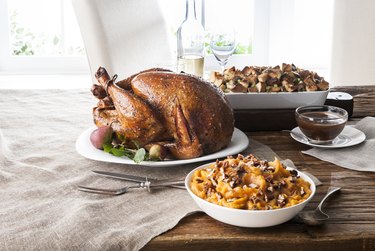
Although a holiday meal is one of the year's highlights for many families, managing the logistics of a big turkey dinner can be challenging. There's only so much room in your oven, and the bird leaves little of it for desserts and side dishes. Cooking your turkey in a roaster oven is an alternative method that frees up oven space for the rest of your dishes, but it's not exactly the same as roasting it in your regular oven.
Matching Your Turkey To the Roaster
Video of the Day
Roasters are measured by the cubic capacity of their cooking well in quarts, with 16- and 18-quart sizes among the most common. As a rough guide, each quart of capacity corresponds to 1 pound of turkey size. If you're using an 18-quart roaster, for example, an 18-pound turkey is the very largest you should buy. It's prudent to buy a slightly smaller bird to allow some margin for error.
Turkey In a Roaster vs. An Oven
A countertop roaster is less a miniature oven than a closed, self-heating roasting pan. Unlike roasting in a regular oven, cooking turkey in a roaster over retains a great deal of moisture in this enclosed space. That helps prevent the turkey from drying out, which is a positive, but it interferes with browning and crisping the skin.
You may want to finish your turkey in the regular oven, if possible, to correct that. You should also avoid peeking at the bird as it cooks, because the relatively low-powered roaster takes longer to get back up to its cooking temperature than a regular oven.
Cooking a Turkey In the Roaster Oven
- Preheat your roaster to 400 degrees Fahrenheit for 20 to 30 minutes with the lid on, while you prepare the bird. This is higher than your actual cooking temperature, but it compensates for the heat you'll lose when you open the lid.
- Remove the neck and giblets from the turkey, and pat it dry inside and out with paper towels. Season the cavity and the bird's exterior with salt and pepper, or other herbs and spices as desired. Transfer it to your roaster's roasting rack.
- Lift the rack and turkey into the roaster's cooking well, taking care not to burn yourself on the hot sides. Replace the lid, and reduce the temperature to 350 F.
- Roast the bird until it reaches an internal temperature of 165 F when tested with an instant-read thermometer. Actual cooking time will vary depending on the size of your bird and roaster, but 13 to 15 minutes per pound is a good rule of thumb.
- Remove the turkey to a serving platter or cutting board, and let it rest for at least 20 minutes under a loose covering of aluminum foil before it's carved. This helps ensure that the whole bird reaches a food safe temperature, and the turkey retains more of its juices when sliced.
A Few Tricks to Improve Your Results
Cooking your turkey in a roaster over can give you an excellent bird, but it won't have the bronzed beauty of an oven-roasted bird. There are a few things you can do to narrow the difference between them:
- For browner, crisper skin, finish the bird in a 450 F oven for the last 20 to 30 minutes of cooking time. Alternatively, remove the drippings from your roaster with a turkey baster and bring its heat back up to 400 F for the last 45 to 60 minutes of cooking time.
- Baste the skin with butter, or butter mixed with a few drops of gravy browning, to produce a more attractive skin.
- The manuals included with some roasters still assume a final temperature of 180 F for the finished bird, which reflects an outdated food safety recommendation. The U.S. Department of Agriculture now considers 165 F to be food-safe for turkey, a revision that provides a juicier, more flavorful bird.
Cook Carefully and Safely
Countertop roasters build up a quantity of very hot steam within the cooking well. Protect your hands when you open the lid, because the steam can cause painful burns. Never position your face over the lid when you're lifting it, for the same reason. If you're reaching into the cooking well to baste the bird, or to lift it in or out, work carefully and protect your hands with a pot holder or oven mitt whenever possible.
Check out this related video from ExpertVillage on Youtube